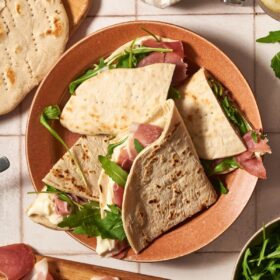
Traditional Romagnola piadina flatbread
Probably the most famous Italian flatbread, piadina is delicious and you can't go wrong serving it with cold cuts and cheese.
Print
Pin
Save Recipe
Servings: 4 people
Calories: 565kcal
Ingredients
- 4 cups all-purpose flour
- ½ teaspoon baking powder
- ½ teaspoon salt
- 1 ¼ cups lukewarm water
- 1.80 oz rendered pork lard*
Equipment
- 1 Fork for stirring at the beginning as well as pricking the piadina before cooking
- 1 large non-stick pan or cast iron skillet for cooking the piadina
- 1 Small bowl for mixing some of the dry ingredients
- 1 flat surface such as a large wooden cutting board for making the dough and rolling out each piadina
- 1 Rolling pin to roll out the piadina
- Plastic wrap for wrapping the piadina dough while it rests
Instructions
- Pour all the flour onto a flat surface, making a well in the center.
- In a small bowl, mix together the baking powder and salt.
- Pour the salt and baking powder mixture and then the rendered pork lard (or extra virgin olive oil) and warm water into the center of the well and start mixing it together with a fork.
- Next knead the dough with your hands for about 10 minutes until quite smooth, uniform, and soft but not sticky (if it’s still sticky, add more flour).
- Make a smooth ball and cover the piadina dough with plastic wrap. Let it rest at least 30 minutes at room temperature (if the dough is being prepared more than 1 hour in advance, you can keep it in the fridge and, when needed, remove one hour before using it).
- Heat a large nonstick pan on medium-high heat.
- Divide the dough into about 5 smaller balls (about 140-150 grams per ball).
- On a flat work surface, use a rolling pin to roll out the dough into a large circle until it reaches the desired thickness (ideally about ⅙ inch) and is as perfectly round as possible. You can dust with flour if it sticks.
- Once the pan is hot, add a circle of dough, pricking it all over with a fork to avoid air bubbles.
- Cook for about 1-2 minutes for a thin piadina, 2-3 minutes for a thicker one, or however long it takes for brown spots to form on the bottom. Then flip the piadina and cook for about the same time on the other side.
- Remember that a piadina should be served hot, so it’s recommended to have your fillings ready (see below for filling ideas).
- Once cooked, you can serve the piadina immediately by placing your desired fillings on one side of the circle and then folding it into a half moon, or by cutting the piadina into triangles to use like pieces of bread.
Notes
*Traditional piadina Romagnola is made with strutto, or rendered pork lard, although in the Romagna area near Rimini it’s made with olive oil; if you prefer the latter, then substitute the lard with 5 tablespoons of extra virgin olive oil.
Serving: 150g | Calories: 565kcal | Carbohydrates: 96g | Protein: 13g | Fat: 14g | Saturated Fat: 11g | Sodium: 297mg | Potassium: 184mg | Fiber: 3g | Sugar: 1g | Calcium: 40mg | Iron: 6mg
Liked this recipe?Follow us NonnaBox for more!